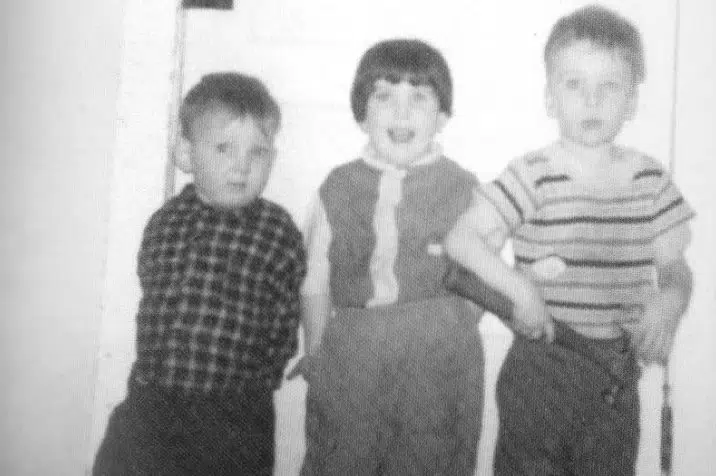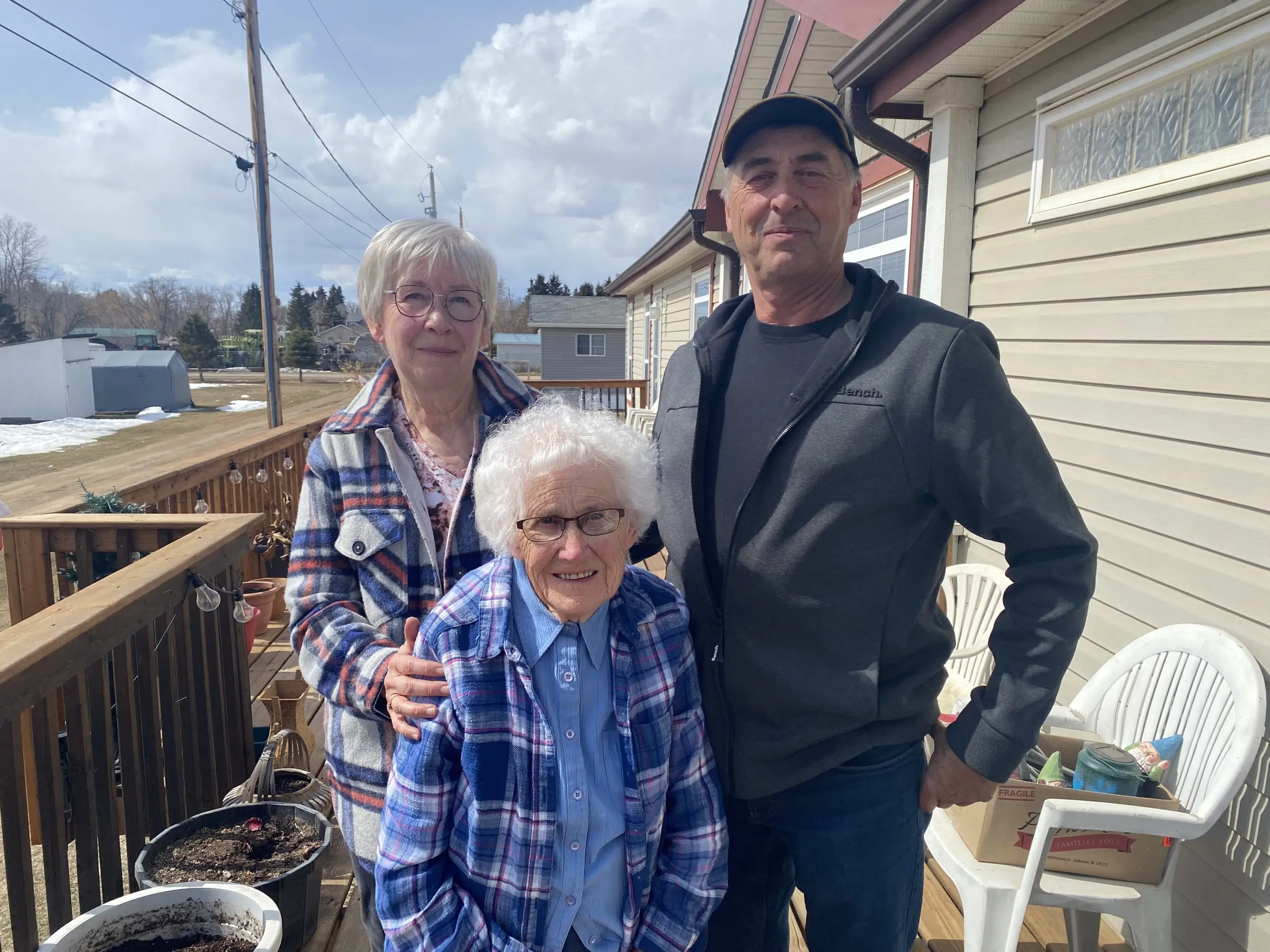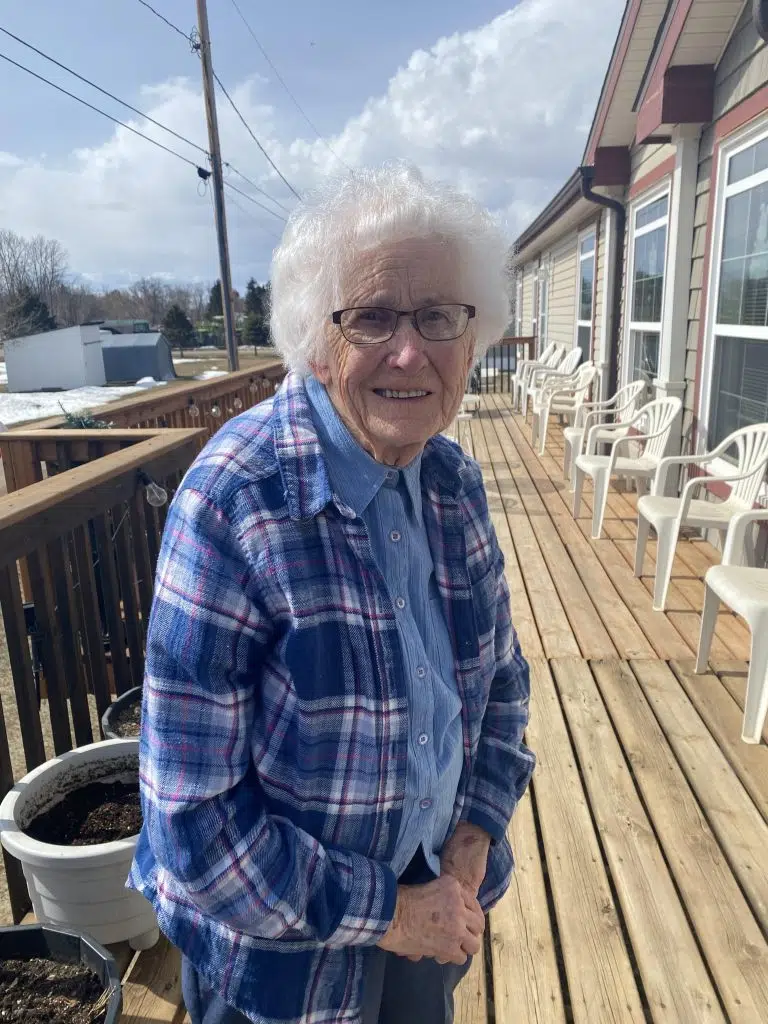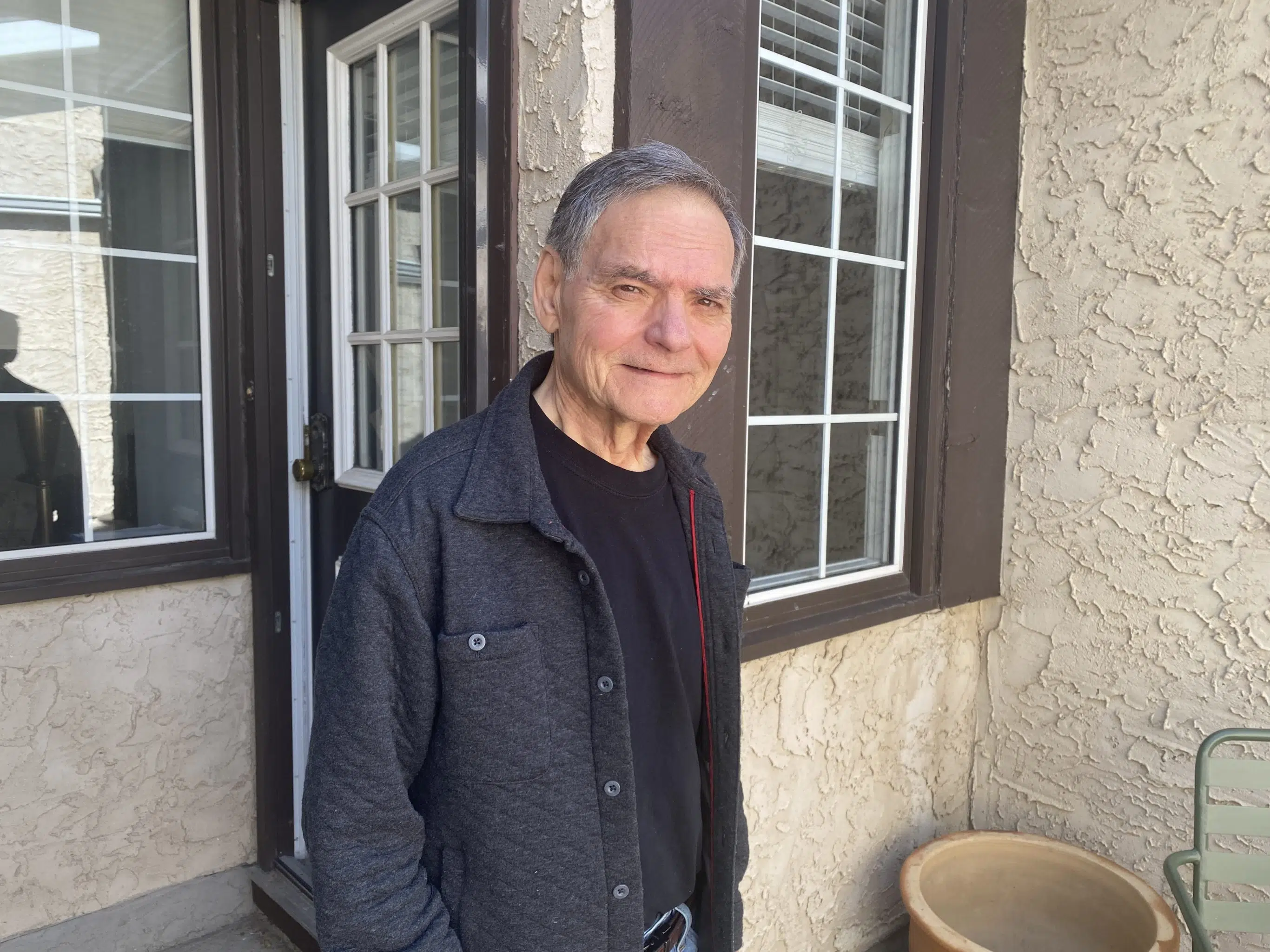The Shell Lake Massacre podcast is a special presentation by Rawlco Radio. The six-part series hosted and produced by Brittany Caffet airs Tuesdays at 1:30 p.m. on 650 CKOM and 980 CJME. Weekly episodes are available for download on Apple Podcasts and Spotify.
Episode 2, “The Night of Fear,” features members of the Simonar family, who were on the scene the day the Peterson family was brutally murdered on their family farm. Caffet also speaks to Ron Shorvoyce, who was a 21-year-old reporter covering the crime for CFQC.
Marjorie Simonar poses for a photo with her children Gale Davidson and Dennis Simonar. The Simonars, who lived across the highway from the Petersons in 1967, quickly learned something was wrong in the morning hours after the massacre. (Photo taken by Brittany Caffet on April 16, 2023).
Listen to Episode 2: The Night of Fear
Content warning: This episode contains depictions of violence and other content that may be disturbing. Listener discretion is advised.
Listen to Episode 1: The Petersons
Transcript of Episode 2: The Night of Fear
Editor’s note: Colin Peterson died 19 days before his third birthday. He is referred to as three years old in the podcast.
Disclaimer: Most of the following transcription is AI generated, and errors may have occurred.
On the morning of Aug. 15, 1967, the community of Shell Lake was thrust into chaos with the discovery of a horrific crime. Nine members of the Peterson family were found dead in their own home.
With no apparent motive and no indication as to who the killer was, people locked their doors and loaded their guns, terrified that their families would be next.
This is the story of one of the worst random mass murders in Canadian history.
This is the Shell Lake Massacre.
You’re listening to Episode 2 – The Night of Fear
I’m your host, Brittany Caffet.
The Peterson farm was unusually quiet when Wildrew Lang arrived shortly after 8 in the morning on Aug. 15. The night before, he and Jim Peterson had made plans for a full day of work together, so Wildrew was surprised when Jim didn’t greet him upon his arrival.
He assumed the family must have overslept and set to work, emptying two feed bins by himself before Jim’s persisting absence became a cause for concern.
It was nearly 9 by the time Wildrew paused his work and approached the Peterson home. As he grew closer to the small white farmhouse, a feeling that something was deeply wrong arose within him. The Petersons’ dog, Skippy, who would normally greet familiar visitors with a friendly bark, was completely silent. The front door to the home sat slightly ajar.
As Wildrew approached the house he called out Jim’s name, but was greeted only by more silence. Wildrew went up the two concrete steps onto the stoop and knocked on the open front door before pushing it open wide enough to step into the house. He would never forget the sight he saw before him.
Jim Peterson lay on his stomach just inside the front door of his own home, a pool of deep red blood beneath him and a scarlet trail smeared across the linoleum floor through the kitchen. Jim wasn’t moving and Wildrew was sure he was dead.
Wildrew frantically backed out of the home and ran to Jim’s station wagon, which was parked in the driveway in its usual place with the keys in the ignition. Wildrew sped away from the farm and into the village of Shell Lake, where he was able to call the Royal Canadian Mounted Police and alert them of what he had seen before making the four-mile drive back toward the Peterson home.
As Wildrew sped back toward the Peterson farm to await the arrival of the RCMP, he saw Alvin Simonar out in his yard.
Alvin and his wife Marjorie lived near Shell Lake on a farm right across the highway from Jim and Evelyn Peterson. From the Simonars’ kitchen window, you could see the Petersons’ fields, and if you walked over to the barn, you could see the small farmhouse that Jim, Evelyn, and their children called home.
Although the highway separated their yards, the houses were quite close together — so close that Alvin and Marjorie’s children can recall yelling back and forth across the highway with the Peterson children on calm nights.
Marjorie, just 38 years old on this fateful day, is now 94. She’s a petite woman with curly white hair — I’ve been told by multiple sources that her hair went from jet black to grey in just a matter of months following the events surrounding the death of the Petersons. I spoke with Marjorie in an assisted living facility in Shellbrook, along with her daughter Gale and son Dennis.
Marjorie Simonar, 94, was neighbours with the Petersons in 1967. She whisked four-year-old Phyllis Peterson away from the murder scene and cleaned her up in the hours after the massacre. (Photo taken by Brittany Caffet on April 16, 2023.)
On the morning of Aug. 15, 1967, something felt amiss from the moment the Simonar family began their day. Their dog Rex, normally happy and boisterous, was acting strangely. He was hiding and cowering behind farm equipment, his tail between his legs. He was terrified.
They could hear the Petersons’ cows across the road bellowing to be milked, a task that was usually accomplished by Evelyn hours earlier. It was clear that something was wrong. Marjorie’s daughter Gale Davidson remembers that morning with stark clarity.
[GALE: “Mom and my cousin Bernice and I, we were making Saskatoon pies and we were looking out the window and were saying, ‘Why aren’t the girls chasing those horses out? What are they doing in the crop?’ This was weird. And in the morning we had milked cows, we had gone out and done the chores, milked the cows … Then all we can see is like our long driveway and then there’s a highway, and then there’s a strip of bush and you can’t see Petersons’ house. And along came Jim Peterson’s car.”]
Dennis Simonar, who was just 10 years old at the time, was out in the yard with his dad Alvin that morning.
[DENNIS: “We had done our chores. My brother was out in the field already. I was fueling up the tractor to go out there and Dad was welding on some stuff. Jim Peterson’s car came down the highway.”]
But Jim Peterson wasn’t behind the wheel of his station wagon — Wildrew Lang was driving. Marjorie recalls being very confused by the brief interaction she saw through her kitchen window.
[MARJORIE: “He had Jim’s car. Which … that’s what really mixed me up, you know; I thought it was Jim because I saw him come out of the car.”]
From inside the home, Marjorie couldn’t hear the conversation that unfolded next, but Dennis heard everything.
[DENNIS: “He stopped at the road and he hollered out to Dad. He said, ‘Can you come with me? There’s something terrible going on at the Petersons’ house. Jim is dead … laying in the doorway … and he is covered in blood.’ So Dad ran out and then I went and chased the horses in that were out of the fence. And by the time when I was halfway across the field, the RCMP came into the yard down the driveway. And by the time I got the horses back into the fence, closed the gate and got up to the house, the cop was just coming out of the house. Dad and Wildrew were outside of the house and the cop came out. He was as white as … just dead white. So he came out of the house and he said, ‘Everybody in there is dead. The mother isn’t in the house. One little girl is still alive.’ So Dad told me to run home and get Mom with the car.”]
And run he did. Dennis went home as fast as his legs would carry him and told his mother that Jim Peterson was dead.
[MARJORIE: “I thought maybe he’d had a heart attack. I knew Evelyn so well and I really knew them both. And so I just jumped in the car and I told (Dennis) and Bernice, ‘You finish’ because I was rolling out pie crust. I was making pies because we’d picked Saskatoons the day before. And so I was busy making these pies and I said, ‘Evelyn will just be devastated …’ I had to go over there. And I can still see it. The cop was in there. The police car was standing by the house.”]
While Dennis had been running home, RCMP Cpl. Barry Richards, the first law enforcement officer on the scene, had re-entered the Peterson home and confirmed that there was, indeed, one little girl still alive. He found four-year-old Phyllis in bed, nestled between the bloody bodies of her sisters Jean and Pearl. He took the tiny girl into his arms and removed her from the house, stepping past the body of Jim Peterson as he carried the only survivor of the massacre out of the home.
When Marjorie pulled up, still confused about what exactly was going on, she saw her husband Alvin holding Phyllis. Blood covered nearly every inch of the child.
Marjorie took Phyllis into her arms and, at the instruction of Cpl. Richards, whisked her away from the Peterson home. She loaded the blood-soaked child into the car and returned to her own farm right across the highway.
When she got home, she did the only thing she could think to do in her state of shock: She cleaned up. She helped Phyllis get out of crimson-splattered pyjamas, sat the four-year-old up on the kitchen counter and began to wash away the visible remnants of the horror that she had survived. She cleaned Phyllis’ arms, her legs and her face, then washed the blood off of the little girl’s pyjamas before hanging them out on the line to dry.
There was nothing else to do. There was nothing to say. Marjorie stood silently in her kitchen, looking out the window toward the Peterson farm wondering what in the world had happened … while bright red blood swirled down the drain of her kitchen sink.
Even 56 years after the events of that morning, Marjorie still clearly remembers the feelings of confusion and disbelief that she experienced.
[MARJORIE: “Well, for all that time, it just didn’t … nothing seemed real. It just seemed like … like it was … a story.”]
It may not have seemed real, but it was. And the reality was that things around the farm couldn’t completely stop, even with an RCMP investigation underway.
Marjorie’s husband Alvin and Wildrew Lang undertook the task of completing all of the chores on Jim Peterson’s farm. They milked the cows and watered and fed all of the animals, the shadow of that white farmhouse and the horror that lay within looming over them.
The body of Jim Peterson lay just inside the front door, a trail of smeared blood on the linoleum telling the tale of how hard he had fought to save himself and his children.
Eleven-year-old Dorothy, who had been sleeping in the living room, was dead on the fold-out cot. In the children’s bedroom just off the living room, the mattresses and blankets on the two double beds were completely soaked in the blood of the Peterson children. The bodies of 13-year-old Mary, five-year-old William and three-year-old Colin were in one bed, and the bodies of 17-year-old Jean and nine-year-old Pearl were in the other. The home that just one day before had been full of life was now a makeshift morgue.
The RCMP investigation was in full swing. In the immediate aftermath of the discovery of the bodies of Jim and the children in the house, the Mounties had one main question they were striving to answer: Where were the mother and baby? There was speculation that Evelyn was responsible for the annihilation of her husband and seven of her children, but that theory just didn’t seem plausible to Marjorie. Her friend had been meek and mild-mannered. Evelyn Peterson was no killer.
It wasn’t long before Marjorie’s doubts were confirmed and the bodies of Evelyn and baby Larry were discovered. Around the backside of the house near a rain barrel, Evelyn Peterson’s body lay sprawled out on the grass. She had been shot four times. Her one-year-old son, Larry, wearing only a diaper, was dead in her arms.
By this time, word of the mass murder had begun to spread across the province and reporters from nearby cities were beginning to arrive in the area. The Simonar farm was abuzz with police, media and neighbours stopping in to try to find out what exactly had unfolded at the Peterson farm.
Marjorie could sense that Phyllis was overwhelmed by it all, so she asked Gale and her other children to take Phyllis away from the house.
[GALE: “Mom had told us, ‘Go take Phyllis out,’ so we went over to where we had bales and haystacks kind of a place. Then she’s chatting with us kids. She said, ‘Mary and Dorothy and I are going to go pick berries today.’ She’s telling us, because she couldn’t perceive that they were dead, obviously, because she’s four. So that I remember, her telling us that this is what she was going to be doing that day. The other thing that Phyllis did mention though at our house that day was somebody was fighting with her dad. So she must have heard something going on.”]
Eventually Phyllis’ Aunt Evie and Uncle Helmer Helgeton arrived to take the little girl back to their home. The chaos around the Simonar farm continued long after the departure of the sole survivor. The first night after the murders was dubbed “The Night of Fear” by local newspapers — a fitting moniker.
[GALE: “It was really traumatic. You just really couldn’t believe that that could happen to somebody. And they’re questioning everybody in the community because … who didn’t like Jim Peterson? And that night there was those tracking dogs walking through the bush and we were just laying there wide awake. Dad probably was laying there with a gun beside the bed. Because you don’t know who killed them, and you don’t know if they are going to come and kill other people.”]
As the Simonar family lay in their home trying to sleep, Ron Shorvoyce was just arriving on the scene. Ron, a reporter for CFQC, was just 21 years old when he was assigned to cover the mass murder in Shell Lake.
[SHORVOYCE: “It was dark, about 10 or 11 p.m. There was some traffic on the road. The RCMP were stopping cars (and) were warning them not to go to the area. And it was kind of scary, you know. You wonder what’s out there. My first stop, I got … I stopped at the pub in Shell Lake. Every good reporter would do that. There wasn’t much action there. They were telling me that everything was happening in Spiritwood. So I went to Spiritwood, I have relatives there. So I arrived in Spiritwood that same night.”]
The next morning, Ron got to work early. Very few details had been released to the public and he was determined to uncover new information that he could report on.
Ron Shorvoyce, 77, was a young reporter for CFQC in 1967 and covered the story of the murdered Peterson family in Shell Lake. (Photo taken by Brittany Caffet in Regina on Aug. 1, 2023).
[SHORVOYCE: “The next day, my goal was to try and find something different … that the other reporters didn’t have. So the next day, I talked to my relatives and I wanted somebody from the family to describe to me what happened because nobody was getting to anybody in the family at that time. So they lined me up with the little girl’s uncle. I met him that afternoon … I think it was in Spiritwood.”]
Ron had managed to secure an exclusive interview with Helmer Helgeton, who was married to Jim Peterson’s sister, Evie. This would be the very first interview with a member of the family … but there was a problem. There were other reporters everywhere. Helmer didn’t want to do a public press conference. He had agreed to speak with Ron and only Ron, so a plan was devised.
[SHORVOYCE:” I had another reporter with me, Len Dick, and Len spread the word that there was going to be a news conference in Shell Lake … and there wasn’t. So everybody went to Shell Lake. So that left us alone, and we did the interview on the side of a house where nobody could see us. We were the first ones to get word from the family as to what happened.”]
Ron also conducted man-on-the-street interviews with people in the community. Most shared the same thoughts: They were scared.
[SHORVOYCE: “I mean, it wasn’t unexpected what they were telling me. You know, you expect people to be shocked and things like that, and they were. People were pouring their hearts out (and) were very afraid as to what happened. It was just pretty emotional.”]
Ron Shorvoyce may have been a young reporter, but he was a professional. Although the material he was covering was horrific, he kept his composure in the moment and tried not to let himself get too emotional about the events going on around him.
[SHORVOYCE: “You know, I knew it was a big story but I never thought of it in that way. I was just doing a job and getting the scoop first … and we did. So you didn’t think about it too much as you were going about it. But later on after it was all over and you had time to breathe, it hits you. It was pretty … pretty tough.”]
A full day had passed since nine members of the Peterson family were found murdered, and the police didn’t have much to go on. They had searched the Peterson home and land to no avail, and had begun searching other farmhouses in the area for any evidence that would help resolve the investigation. They knocked on the doors of hundreds of homes, interviewed the occupants, and checked weapons, hoping they would find a clue as to who had done this … and why.
Just a 40-minute drive away in another small community, a farmer and his wife sat in the living room of their small farmhouse discussing the news they had heard about the murder of an entire family in Shell Lake.
They had no clue that the killer was in the next room.
Credits
The Shell Lake Massacre is a Rawlco Radio production. The show was researched, written, produced and hosted by Brittany Caffet. Supervising producers Sarah Mills and Murray Wood. Story consultant Craig Silliphant. Production support by Dallas Doell. Graphic design by Jennifer Losie. Special thanks to Erin McNutt and John Gormley.














